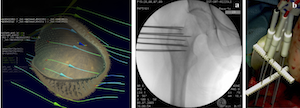Electroporation is the phenomenon in which cell membrane permeability is transiently increased by exposing the cell to short high electric field pulses. The applied electric field causes a proportional transmembrane voltage that superimposes on the natural transmembrane resting potential. In isolated cells and cell membranes, it has been observed that when the artificially induced transmembrane voltage surpasses a threshold, electroporation occurs because the membrane destabilizes through a not fully understood mechanism. Similarly, in tissues, it is generally accepted that electroporation occurs when, for a specific tissue type and a specific pulse protocol, the applied electric field magnitude surpasses a threshold. This assumption has facilitated the development of electrode setups for clinical electroporation and has allowed performing crude treatment planning for electroporation based treatments. However, electric field modeling in tissues subjected to electroporation is not as straightforward as it may appear at first glance. To begin with, it needs to be understood that, in tissues, electroporation is accompanied by a significant and instantaneous increase in electrical conductivity (e.g. up to x5 in muscles and up to x20 in the skin) which may have a huge impact on electric field distribution and, therefore, on electroporation. This process and how it is incorporated into tissue electroporation models are the main topics of the talk. A number of in silico modeling examples are presented in which the importance of tissue conductivity changes due to electroporation is illustrated. But conductivity changes are only a part of the story; other processes such as the memory effect observed in electroporation have not yet been satisfactorily incorporated in models. The talk will pose some of these open questions regarding electric field modeling in tissues for electroporation based treatments.

 PDF version
PDF version
